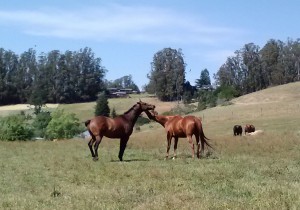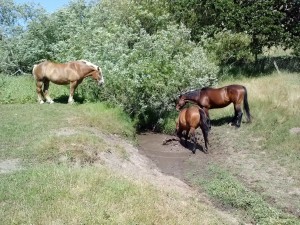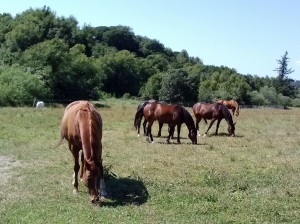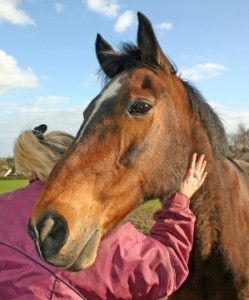 It was one of those crystalizing moments, when lots of swirling puzzle pieces suddenly come together and the picture makes sense.
It was one of those crystalizing moments, when lots of swirling puzzle pieces suddenly come together and the picture makes sense.
I was listening to an interview about Power and Leadership with Linda Kohanov, founder of EponaQuest and author of a new book, “The Power of the Herd.” I had read her first book, “The Tao of Equus,” last year, and was looking forward to the interview.
I wasn’t disappointed. “The Power of the Herd” presents a new view of Power and Leadership. Kohanov described how this evolved as a result of her work with a rescued stallion who had been abused:
“The most surprising thing to me was that I discovered that kindness, sympathy and understanding weren’t enough to heal the wounds of that level of misused power, that I had to become powerful myself. And yet I had to become powerful in a different way than the kind of Domininance/Submission power that abused him to begin with. And I really wasn’t sure what that was.” Healing With Horse Telesummit 2013
Kohanov went on to describe the journey she embarked on to discover – and embody – the power needed to heal that stallion, and what she learned. I was struck by three key ideas:
- Predatory vs. Non-Predatory Power
- The Importance of Boundaries
- The Role of Nurturing and Companionship
These came together with other teachings to give me a new understanding of leadership, and of power.
The Puzzle Pieces
That’s the background. Here’s where the pieces of the puzzle began to fall together.
PREDATORY vs. NON-PREDATORY POWER
Over time, through research, observation and first-hand work with horses, Kohanov developed a model of what she calls “Predatory Power” vs. “Non-Predatory Power.” While horses are “prey” animals, they are herd animals and leaders of the herd certainly exert power over the other members. Language is important, though, and the term “prey” conjures images of quivering victims. This is not what she observed, so she chose the term “non-predatory” power.
What’s the difference, you ask?
Predatory Power: Leaders nourish themselves at the expense of the others.
Non-Predatory Power: Individual and group needs are met.
Predatory Power: Leaders value territory over relationships.
Non-Predatory Power: Leaders value relationships over territory.
Predatory Power: Leaders value Goals over Process – “The end justifies the means.”
Non-Predatory Power: Leaders value Process over Goals – The end does not justify the means.
While Kohanov developed this model as a result of working with horses, she works with people as well, and there are of course parallels to human leadership. She went on to talk about classic “dominance” leadership, and I was reminded of something Mark Rashid, a well-known horse trainer and author, teaches.
In his book, “Horses Never Lie,” Rashid describes two types of leaders he has observed in herds – often within the same herd: “Dominant” leaders verses “passive” leaders. Dominant leaders are the “alpha horses” that rule the herd: They eat first, drink first, and spend a lot of time reminding the others who is boss. But the other type of leader, rather than constantly asserting its dominance, seems to be chosen by the others. Why are they chosen? As prey animals, horses need to conserve energy so that they have it when they need to escape.
“Primarily they conserve energy in a herd situation by willingly following a leader that they know won’t cause them unnecessary stress or aggravation. In the herds that I had a chance to work with, it was evident that seldom, if ever, was the chosen leader the alpha horse. Rather, it was a horse that had proven its leadership qualities in a quiet and consistent manner from one day to the next. In other words, it was a horse that led by example, not by force.” (Horses Never Lie, Skyhorse Publishing, ©2000, p. 38.)
He proposed that it made sense to him, in working with horses, to be the kind of leader they would want to follow, rather than having to constantly force them to follow him.
That sounds great, except… language is important.
I was impressed with Rashid’s ideas, and I translated them not only to my own work with horses but to people, too: I kept thinking about my own experiences with “dominant” or “alpha” human leaders vs. leaders who lead by example. But again, language is important, and calling them “passive leaders” was a stumbling block for me. Apparently I wasn’t alone; in his new book, “Life Lessons from a Ranch Horse,” Rashid admits that created “quite a stir…After all, how can one be passive and still be a leader?”
Well, Kohanov’s language and examples helped this to make more sense. If I go back and substitute “non-predatory” for “passive” all my resistance goes away.
But wait, it gets better!
VULNERABILITY AND BOUNDARIES
Kohanov went on to talk about how predatory leaders prey on their followers’ vulnerabilities, whereas non-predatory leaders protect their followers, honor boundaries and make it safe for members to be vulnerable in the group. Non-predatory leaders, she said, shield the weak, and members can show vulnerability in groups.
Here I was reminded of Brene Brown’s TED talk about vulnerability. I was also reminded of something my friend Vicki Dello Joio teaches:
“Boundaries remove barriers.”
What? I admit, the first time I heard Vicki say that it left me scratching my head. What’s the difference between a boundary and a barrier? How can a boundary remove a barrier? But what Kohanov said about vulnerability, and about boundaries, helped me to finally get it:
“When you’re setting a boundary, you’re simply claiming the space you need to feel safe and present and, as a consequence, more connected to the person you’re setting the boundary with.”
This makes it easier – and safer – to be vulnerable as well. This is only possible in non-predatory power systems.
One more a-ha!
NURTURING AND COMPANIONSHIP
Kohanov also explained another aspect of herd behavior that caught my attention:
“There’s also another element to herd behavior that’s really important, which is acts of companionship and nurturing. They spend a large amount of time just being really quiet together, resting together, mutual grooming, grazing together, and all of those elements create this glue that begins to hold the herd together.”
This glue, this power, isn’t about fear, and it isn’t about territory. It’s about acts of companionship and nurturing.
But that’s not the a-ha.
Kohanov doesn’t claim that “dominant” leadership is always bad and that the “lead by example” leadership of “chosen” leaders is always good. Nor does she claim that successful herds are always supportive and nurturing.
As part of her research for the book, Kohanov studied various herding cultures, where humans live in close proximity with the herds they tend.
“What you find with Master Herders in traditional herding cultures is that they actually get to the point where they can use these various roles at will for specific purposes. So that a Master Herder knows when to act as Dominant, when to act as Leader, and when to act as Nurturing Companion.”
That requires consciousness or, as my friend Michael F. Broom teaches, conscious use of self. Conscious use of self isn’t only about recognizing one’s faults and getting out of one’s own way, but is about being conscious about what tools, or style, to use when.
Which brings me to something I teach (and my clients hear this a lot): We get to choose.
We get to choose not just our default mode, but we get to consciously choose which mode is right for the situation we’re in now.
A-ha.
Power is not a dirty word
Yes, there was a lot packed into that interview, so much that I had to listen to it several times. And when the pieces came together, this is what I saw:
- It takes non-predatory power to set the boundaries that make members of a herd feel safe enough to allow themselves to be vulnerable.
- Every member is responsible for setting and respecting boundaries; a member doesn’t have to be The Leader to set boundaries, but no member can be a (non-predatory) leader without setting boundaries.
- Companionship and nurturing are also powerful and can bring and hold a herd (group) together.
- There are, of course, various styles of leadership and different types of power, with different applications. No one type is ideal all of the time (our greatest strengths become our greatest weaknesses when taken to extreme). Dominance is necessary at times.
- The real power is in knowing what type of power to employ when – and being able to do it.
Part of what was so interesting about all of this is that in almost every instance I could replace the word “herd” with “group,” “team” or “organization” – human herds. This all applies to human interactions as well as to equine interactions, and it has given me new insight into what many smart people are teaching about human interactions and leadership. (Funny how the horses keep giving me insight into other humans, and into myself. Even when we’re just talking about them.)
And whether it applies to horses and herds or to humans and organizations, Power is not a dirty word. Everything depends on the type of power that is being employed, and when.
A-ha.
 In my previous post I alluded to learning lessons from my friends at Equistar Farm, lessons I’m applying in surprising ways. Here is Lesson Number Two:
In my previous post I alluded to learning lessons from my friends at Equistar Farm, lessons I’m applying in surprising ways. Here is Lesson Number Two:




 Twitter
Twitter LinkedIn
LinkedIn Facebook
Facebook